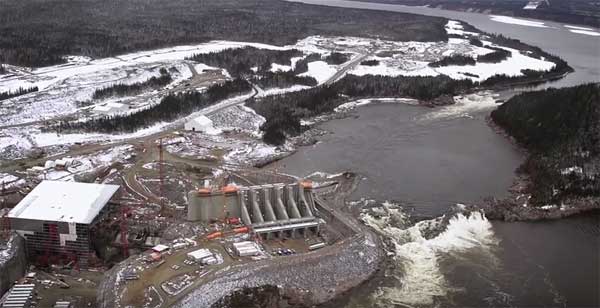Like this blog? rabble is reader-supported journalism. Chip in to keep stories like these coming.
There may be increasing consensus that the Muskrat Falls hydroelectric dam project in Newfoundland and Labrador is a huge mistake. The Globe and Mail reports, “Former top provincial bureaucrats Ron Penney and David Vardy … recently called the project ‘one of the most unfortunate public-policy decisions in the history of the province.’ Many Newfoundlanders wish they could simply pull the plug.”
Among the economic concerns the Muskrat Falls becoming an over-budget burden on Newfoundland article highlights:
1. “In September, Nalcor upped its cost estimate for Muskrat Falls to $7.7-billion from an initial $6.2-billion. The total comes to more than $9-billion, when financing costs during the construction phase are included. That may not be the end of cost overruns before the power starts flowing in 2018 — or later.”
2. “[It is estimated] that Muskrat Falls will increase Newfoundland’s gross debt by 50 per cent.”
3. “Oil and gas prices [have] tanked, leaving the provincial government facing massive deficits far into the future and dismal prospects for fetching premium prices for the project’s power on export markets.”
4. “A federal guarantee was needed to get this project off the ground in itself testifies to its iffy economics.”
5. “The rates paid [for the power by the Nova Scotia utility Emera] are locked in, leaving Newfoundland responsible for cost overruns on Muskrat Falls.”
6. “About 40 per cent of Muskrat Falls energy is slated for consumers in Newfoundland via an underwater link from Labrador [but] concerns about the reliability of Muskrat Falls power — transported across several climate zones and merciless terrain — make that unlikely.”
7. “The commodities crash has dimmed prospects for selling the remaining 40 per cent of Muskrat Falls power to mining developments in Labrador.”
8. “Reliability concerns are a major obstacle to finding buyers south of the border.”
The article also notes, “[The dam’s] clean-energy marketing pitch was hurt by a recent peer-reviewed study by Harvard University scientists who looked at the effects of dams built at Muskrat Falls. It found that ‘methylmercury concentrations from flooding for hydroelectric development will be far greater than those expected from climate change,’ threatening local Innu populations.”
Based on the results of the Harvard paper, it is estimated that methylmercury inputs into Lake Melville could increase by 25 per cent to 200 per cent.
On Dec. 1, CBC reported, “A member of the Muskrat Falls environmental assessment panel is speaking out after new research from Harvard University suggests the potential for mercury contamination in fish and seal is greater than initially predicted. …[Cathy] Jong believes that the government and Nalcor are not doing enough to minimize the risk of contamination in Lake Melville. Jong said Nalcor ignored a recommendation by the environmental assessment panel to clear all trees and brush from the reservoir area [which the panel felt was first line of defence in keeping mercury out of the flood zone]. Instead, she said Nalcor predicted there would be dilution in the mercury levels.”
That article also notes, “After reviewing a study that involved Harvard researchers, Nalcor Energy announced it would conduct a follow-up monitoring study and issue consumption advisories when mercury levels rise in Lake Melville. Jong does not believe the consumption advisories work.”
Consumption advisories don’t work because it means Inuit people are then forced to purchase store-bought food. As we noted in the blog Nunatsiavut threatened by mercury contamination from Muskrat Falls dam (Sept. 26, 2015), “The nutritional, cultural, social, economic and spiritual value of traditional food consumption for Inuit and other Indigenous groups has been well-documented. There are also major nutritional and other health implications with a shift from traditional country goods to store-bought foods. A shift away from country food diets could mean a rise in obesity, diabetes and cardiovascular disease.”
The Make Muskrat Right campaign is calling for “reasonable changes” to limit the amount of methylmercury pollution resulting from the dam. The campaign has a Facebook page here, a website here, a 30-second video here and are using the hashtag #MakeMuskratRight on Twitter.
Council of Canadians chairperson Maude Barlow has written a nine-point critique of major dams (higher than 15 metres). The Muskrat Falls hydroelectric dam project includes a 32-metre high north dam and a 29-metre south dam. She highlights major dams often harm Indigenous peoples, cause mercury poisoning, and are a source of greenhouse gas emissions.. She also writes that pre-conditions for approval include exploration of more environmentally sound alternatives; environmental, accountability to local people who have the right of veto; protection of local food supplies and a guarantee of local health protection.
Image from the Make Muskrat Right video.
Like this blog? rabble is reader-supported journalism. Chip in to keep stories like these coming.



